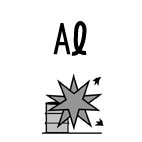| Case Name |
Explosion of hydrogen gas at non-industrial waste incineration facilities |
| Pictograph |

|
| Date |
July 6, 1995 |
| Place |
Isehara, Kanagawa, Japan |
| Location |
General waste incinerator |
| Overview |
An explosion occurred in an incinerator for non-industrial wastes. A large amount of aluminum included in non-industrial wastes, produced a solid lump of ash, which suspended the operation of the incinerator. It exploded on adding water. During waste treatment, where there is various unstable work and the composition and properties of handled materials differ significantly, it is important to identify dangerous points, provide safety education, and prepare manuals. |
| Incident |
At incineration facilities for non-industrial wastes, an explosion occurred during clean-up operation of clinkers piled in a hopper chute at the lower part of the incinerator. An operator suffered burns due to hot gas and ash. A clinker is a solid lump made of incinerated ash adhered to molten metals such as aluminum at a high temperature. |
| Processing |
Waste and disposal |
| Process Flow |
Fig2.Unit process flow
|
| Substance |
Aluminum, Fig3 |
| Type of Accident |
Explosion |
| Sequence |
01:00. on July 6th, 1995. An abnormality was confirmed in an ash chute damper of the incinerator, and combustion operation was discontinued.
01:45. Loading of wastes to a hopper was stopped, and preparatory work for burying fire started.
04:00. Burying fire work was completed.
08:20. During ash chute work at an inspection hole, a solid layer, which seemed to be a clinker, was found. The clinker was being removed by crushing with a thrust chisel while water was intermittently poured.
09:59. An explosion occurred in the ash chute, and hot gas and ash spouted out from the inspection hole. |
| Cause |
Inflammable gas consisting mainly of hydrogen generated in the ash chute and the ash extruder formed a combustible gas-air mixture, which was ignited by a hot clinker. |
| Response |
The injured worker was taken to hospital by ambulance. |
| Countermeasures |
1. As waste including aluminum easily forms a clinker, which causes an ash blockage, it should not be incinerated in large quantities.
2. A camera and a temperature sensor to monitor ash blockage will be installed in the chute.
3. Natural cooling will be adopted instead of forced cooling by water for ash removal work.
4. A manual for safety work will be prepared. |
| Knowledge Comment |
On contacting water, the high-temperature waste incineration ash can generate hydrogen. Aluminum generates hydrogen on contacting alkali and acid, even at a low temperature. |
| Background |
There were two basic factors. 1) A large quantity of aluminum, which has to be managed as industrial waste, was brought in as non-industrial waste. Its incineration without knowing this fact resulted in the generation of a hot clinker, and operation was suspended. 2) Workers lacked safety knowledge such as that hydrogen can be generated by adding water to a hot ash containing metals such as aluminum. Consequently, they put water on the hot clinker in the clinker clean-up operation. The accident was inevitable with the facilities used at the time. |
| Incidental Discussion |
Non-industrial wastes such as domestic wastes contain various materials including hazardous ones, even though separated garbage collection has advanced. In this accident, there was a possibility of bringing in waste that should have been managed as industrial waste. There was an identical accident in 1983, and a related report was published in 1994. Although the publication was delayed for legal reasons it had been made public before this accident occurred. |
| Reason for Adding to DB |
Example of explosion caused due to unexpected generation of hydrogen gas |
| Scenario |
| Primary Scenario
|
Poor Value Perception, Poor Safety Awareness, Insufficient Recognition of Risk, Organizational Problems, Inflexible Management Structure, Insufficient Education/Training, Carelessness, Insufficient Understanding, Insufficient Recognition of Risk, Planning and Design, Poor Planning, Regular Operation, Erroneous Operation, Water Injection without Special Care, Bad Event, Chemical Phenomenon, Abnormal Reaction, Secondary Damage, External Damage, Explosion, Bodily Harm, Death, Bodily Harm, Injury, 2 person injured
|
|
| Sources |
Kenji Yasuda, Hideo Tagota Takashi Miyakawa, Yasuo Shimizu, Hydrogen gas explosion in non-industrial waste incineration facility in Kanagawa Prefect, Safety engineering, No.198, pp.183-187(1997).
|
| Number of Deaths |
1 |
| Number of Injuries |
2 |
| Physical Damage |
An ash chute was partially deformed. The adjoining moisture chamber was partially damaged. |
| Multimedia Files |
Fig3.Chemical formula
|
| Field |
Chemicals and Plants
|
| Author |
WAKAKURA, Masahide (Kanagawa Industrial Technology Research Institute)
TAMURA, Masamitsu (Center for Risk Management and Safety Sciences, Yokohama National University)
|
|